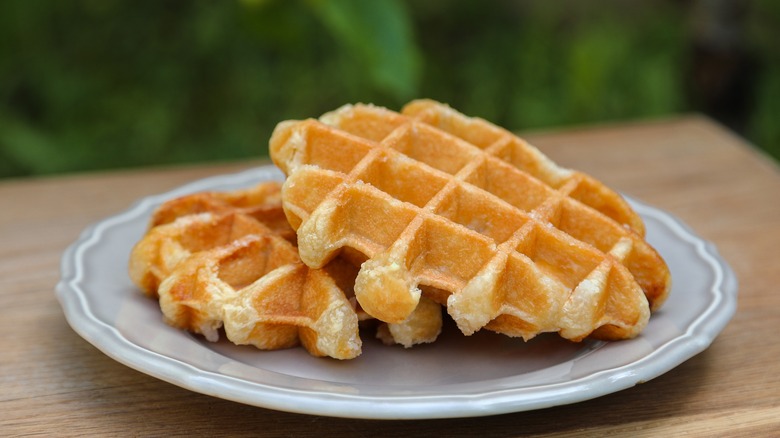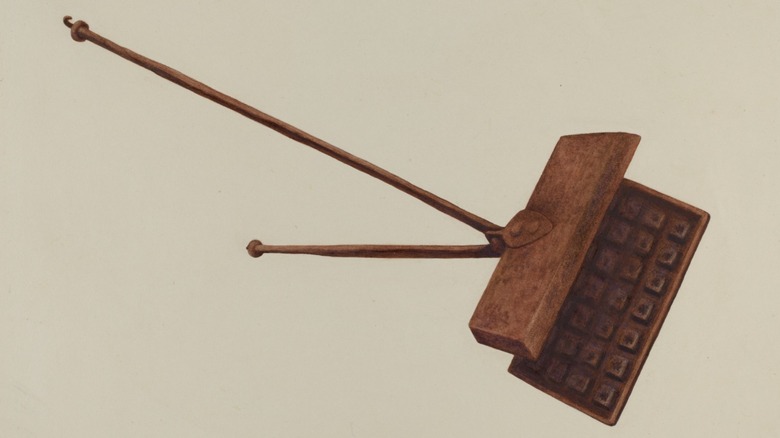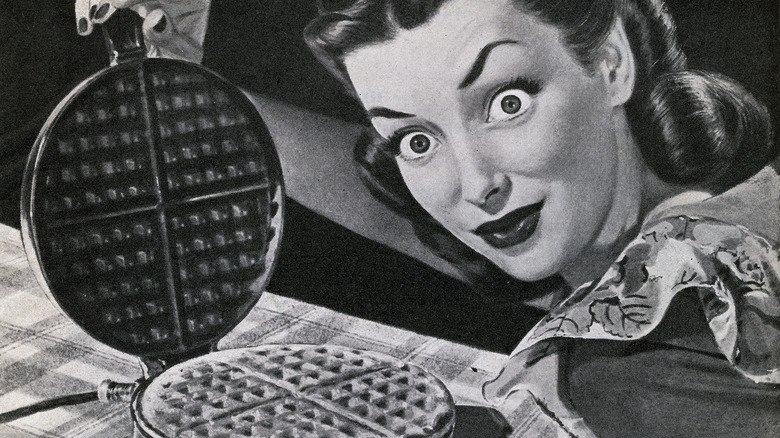Waffles Are Deeply Ingrained In American History
Whether you like them with chocolate chips and whipped cream or a side of fried chicken, waffles are almost universally beloved. Sure, buttermilk pancakes are probably more popular in general, but they pale in comparison to waffles when it comes to versatility. Waffles can be sweet or savory, fluffy or crispy; their dimples can be deep, shallow, or even bubbly, as seen in Hong Kong-style waffles. There are countless varieties of waffles around the world, and it seems that each one inevitably arrives in the U.S., where we gobble them up with fervor. We Americans love our waffles, and in fact, we always have.
Believe it or not, waffles came to America on the Mayflower. When the Pilgrims broke from the Church of England and fled their native country, they didn't go straight to Plymouth Rock. They originally settled in the Netherlands, a country so obsessed with waffles that they established a waffle makers' guild back in the 13th century. The Pilgrims spent over a decade there and developed a taste for waffles (how could they not?). However, they began to face serious economic challenges and became fearful of assimilating into Dutch society to the point of losing their English history and language. So, they departed on their famous Atlantic voyage, bringing waffles to the shores of Massachusetts in 1620.
The surprisingly long history of waffles
The Pilgrims discovered waffles through the Dutch, who are also responsible for its name (though they spell it "wafel"). But, waffles didn't begin in the Netherlands. The history of waffles goes deeper into the annals of history than you might imagine, all the way back to the Ancient Greeks, who ate obelios, simple cakes cooked between two metal plates. This technique spread throughout Europe, largely thanks to the Catholic Church, which treated them as a compliment to communion wafers.
While the Dutch can't claim to have invented waffles, they deserve all the credit for introducing them to America. Just six years after the Pilgrims arrived in Massachusetts, Dutch settlers established New Amsterdam, which then became New York City in 1665. It was here that waffles began to take off in America. By the 1740s, residents of the city were having entire parties centered on waffles. Known as "wafel-frolics," these grandiose meals were often accompanied by raunchy dinner theater.
Thomas Jefferson may have also played a role in bringing waffles to America's attention. In 1789, he returned home from serving as the foreign minister to France, bearing with him many tokens of Europe. These included four waffle irons from a visit to Amsterdam. Records from Jefferson's home of Monticello include a waffle recipe written by Dutch New Yorker Anna De Peyster. It's possible that waffles were served at Monticello, or even during Jefferson's time in the White House.
Waffles take over America
As waffles ingrained themselves in American life, they were transformed by the culture. Back in Europe, waffles were considered a dessert or a snack, and they were typically eaten plain. It was only after arriving in the United States that waffles became a breakfast food and partnered up with maple syrup.
Americans would go on to make many notable contributions to waffle history. Perhaps the most important of these occurred in 1869, when an inventor from Toy, New York, by the name of Cornelius Swartwout patented a stovetop waffle iron made from cast iron. People no longer had to hold their waffle press over the hearth throughout the cooking process, a good way to burn your hands, and it turned out waffles with great efficiency. 1918 saw the first electric waffle iron, produced by General Electric, and it soon became a staple of American kitchens.
Waffles, it seems, are ripe for endless innovations, and one of the most impactful came from, or all places, a mayonnaise company. In 1935, brothers Frank, Anthony, and Samuel Dorsa started making mayonnaise in the basement of their parents' San Jose home. Centering their marketing on the use of fresh eggs (as opposed to Miracle Whip), the trio named their product Eggo. They soon expanded into other foods, and in the 1950s, Frank invented a means of mass-producing waffles to freeze and sell in grocery stores, making waffles an everyday breakfast across the nation.


